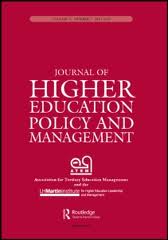|
News & Views item - December 2011 |
![]() The Relationship Between Universities' Academic and Professional
(Administrative) Staff. (December 6, 2012)
The Relationship Between Universities' Academic and Professional
(Administrative) Staff. (December 6, 2012)
 The
December 2011 issue of the Journal of
Higher Education Policy and Management
carries a paper§ by
Judy Szekeres, South Australian Institute of Business & Technology, Adelaide,
entitled "Professional staff carve out a new space".
The
December 2011 issue of the Journal of
Higher Education Policy and Management
carries a paper§ by
Judy Szekeres, South Australian Institute of Business & Technology, Adelaide,
entitled "Professional staff carve out a new space".
In an earlier paper (2004)* Dr Szekeres "lamented the ‘invisibility’ of professional staff in Australian higher education", and pointed out that they already exceeded half of the university workforce. She summarised the relationship between academics and administrative staff as the administrators "experienc[ing] a high level of frustration in their relationships with academic staff and with their institutions."
Her follow-up paper looks at changes which had occurred by 2009.
It would seem that by 2009, professionals had carved out a more critical space in the sector than they had been able to do by 2004. At senior levels, professionals are no longer restricted to specialist roles such as human resources or information technology or building services but have moved into the Pro- and Deputy-Vice-Chancellor space, roles previously reserved for senior academics. However, has there been much change in the junior or middle management roles? This paper considers the literature over the last six years as it relates to professional staff, looks at the changing statistics in Australia around employment of professional staff, and considers what changes have taken place for professional staff at all levels.
Dr Szekeres then comes to the conclusion that "[d]espite some changes... [t]here is still an uneasy relationship between academic and professional staff," and after allowing that modern universities are complex organisations, she cautions that: "In a customer-driven fee-paying environment, we need to ensure our systems are in order and that the quality of the educational experience meets expectations. To achieve this, academics and professionals ‘must work more closely together’... a cooperative community based on trust and respect for each others’ roles is needed."
How to achieve that goal she leaves an open question writing that perhaps "it may happen over time as universities shift into a new space where professional staff become increasingly more credentialed and more professional. [In any case] professionals still have some way to go to claim their space in universities."
Dr Szekeres acknowledges that: "The senior administrative group is seen as making many of the key resource and policy decisions, and academics are now operating in an environment where they are being managed by professional managers who have little understanding of their roles or career trajectories."
But she is rather dismissive of this analysis: "In one view, the role of academics is thereby diminished but this is also a contested view. It could be argued that this leaves academic staff to concentrate on teaching and research – that ‘a professional cadre of managers allows [academics] to return to their millennia-old tradition’... The view that academics and professionals have contrasting purposes needs to be challenged."
_________________________________
§Szekeres, J. (2011) Professional staff carve out a new space. Journal of Higher Education Policy and Management, 33, 679–691.
*Szekeres, J. (2004) The invisible workers. Journal of Higher Education Policy and Management, 22, 7–22.